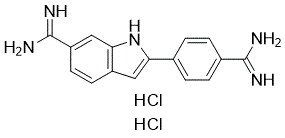All AbMole products are for research use only, cannot be used for human consumption.

DAPI dihydrochloride is a blue fluorescent nucleic acid stain, preferentially binds dsDNA and associates with the minor groove AT clusters. Association of DAPI with dsDNA increases fluorescence approximately 20-fold, with an emission maximum of 460 nm. The increase in fluorescence is believed to be due to displacement of water molecules from the minor groove and DAPI. DAPI can also bind RNA and emits at a longer wavelength of 500 nm, with only a 20% increase in fluorescence.
Protocols for Counterstaining with DAPI:
Immunofluorescence Staining
Note: Cells may be fixed by method of choice, such as with 4% paraformaldehyde. DAPI staining is done after staining for other markers. Fixation and permeabilization of cells is not necessary to counterstain with DAPI.
1. Fix cells using method of choice.
2. Incubate the cells with phosphate buffered saline (PBS) for 15 minutes.
3. Dilute the DAPI solution (we recommend to 300 nM) with PBS. Remove excess PBS from the slide and cover with DAPI solution, making sure the cells are completely covered.
4. Incubate for up to 5 minutes. Rinse the slide several times to remove all free DAPI. It is recommended to use a mounting medium with antifade reagent to reduce fluorescence quenching. The slide is ready to view under the microscope with appropriate filters.
Nuclear Staining for Flow Cytometry
Note: Cells may be fixed with 4% paraformadehyde or absolute ethanol.
1. Fix cells with absolute ethanol or 4% paraformaldehyde.
2. Centrifuge, discard the supernatant, and add 5 ml of PBS, allowing cells to rehydrate for 15 minutes.
3. Dilute the DAPI to 3 µM (recommended) in staining buffer.
4. Centrifuge cell suspension from step 3 above, discard supernatant, and add 1 ml of DAPI solution, then incubate at room temperature for 15 minutes.
5. Analyze by flow cytometry using an instrument with appropriate lasers.

ACS Nano. 2025 Jun 24;19(24):22357-22375.
Harnessing Surface Hydrophilicity of Inhalable Nanoparticles for Precision Delivery of Glucagon-like Peptide-1 Receptor Agonists or Anti-Asthmatic Therapeutics
DAPI dihydrochloride purchased from AbMole

Adv Sci (Weinh). 2024 Sep 13.
SKAP1 Expression in Cancer Cells Enhances Colon Tumor Growth and Impairs Cytotoxic Immunity by Promoting Neutrophil Extracellular Trap Formation via the NFATc1/CXCL8 Axis
DAPI dihydrochloride purchased from AbMole

Biomed Pharmacother. 2024 Sep 08;179:117389.
Intrathecal administration of MCRT produced potent antinociception in chronic inflammatory pain models via μ-δ heterodimer with limited side effects
DAPI dihydrochloride purchased from AbMole

Biol Direct. 2024 Nov 11;19(1):110.
Sorafenib-induced macrophage extracellular traps via ARHGDIG/IL4/PADI4 axis confer drug resistance through inhibiting ferroptosis in hepatocellular carcinoma
DAPI dihydrochloride purchased from AbMole

Biol Direct. 2024 Nov 15.
Sorafenib-induced macrophage extracellular traps via ARHGDIG/IL4/PADI4 axis confer drug resistance through inhibiting ferroptosis in hepatocellular carcinoma
DAPI dihydrochloride purchased from AbMole

Cell Oncol (Dordr). 2024 Nov 25.
Lenvatinib-activated NDUFA4L2/IL33/PADI4 pathway induces neutrophil extracellular traps that inhibit cuproptosis in hepatocellular carcinoma
DAPI dihydrochloride purchased from AbMole

CNS Neurosci Ther. 2024 Sep 24.
Decreased cold-inducible RNA-binding protein (CIRP) binding to GluRl on neuronal membranes mediates memory impairment resulting from prolonged hypobaric hypoxia exposure
DAPI dihydrochloride purchased from AbMole

Plant Sci. 2024 Nov;348:112227.
Optimizing pollen germination and subcellular dynamics in pollen tube of Torreya grandis
DAPI dihydrochloride purchased from AbMole

Purinergic Signal. 2024 Sep 26.
Astrocytic P2X7 receptor regulates depressive-like behavioral reactions of mice in response to acute stressful stimulation
DAPI dihydrochloride purchased from AbMole

Adv Mater. 2023 Feb 22;e2211138.
Genetically Programmable Vesicles for Enhancing CAR-T Therapy Against Solid Tumors
DAPI dihydrochloride purchased from AbMole

Nucleic Acids Res. 2022 Aug 12;50(14):7938-7958.
HDAC1 and PRC2 mediate combinatorial control in SPI1/PU.1-dependent gene repression in murine erythroleukaemia
DAPI dihydrochloride purchased from AbMole

Oncol Lett. 2022 May;23(5):163.
AK4P1 is a cancer-promoting pseudogene in pancreatic adenocarcinoma cells whose transcripts can be transmitted by exosomes
DAPI dihydrochloride purchased from AbMole

Appl Biochem Biotechnol Appl Biochem Biotechnol. 2022 Jul 1.
Apatinib Through Activating the RhoA/ROCK Signaling Pathway to Cause Dysfunction of Vascular Smooth Muscle CellsMuscle Cells
DAPI dihydrochloride purchased from AbMole

J Nanobiotechnology. 2021 Nov 25;19(1):391.
Nanovesicles derived from bispecific CAR-T cells targeting the spike protein of SARS-CoV-2 for treating COVID-19
DAPI dihydrochloride purchased from AbMole

Ann Biomed Eng. 2021 Jun;49(6):1551-1560.
Comparison of in Vascular Bioreactors and In Vivo Models of Degradation and Cellular Response of Mg-Zn-Mn Stents
DAPI dihydrochloride purchased from AbMole

Reprod Sci. 2021 Jun 2.
LncRNA HOXA-AS2 Activates the Notch Pathway to Promote Cervical Cancer Cell Proliferation and Migration
DAPI dihydrochloride purchased from AbMole

Theranostics. 2020 Apr 27;10(13):5671-5686.
SUMO1 modification of methyltransferase-like 3 promotes tumor progression via regulating Snail mRNA homeostasis in hepatocellular carcinoma
DAPI dihydrochloride purchased from AbMole

Aging (Albany NY). 2020 Jun 9;12(11):11025-11041.
LncRNA ADAMTS9-AS2 inhibits gastric cancer (GC) development and sensitizes chemoresistant GC cells to cisplatin by regulating miR-223-3p/NLRP3 axis
DAPI dihydrochloride purchased from AbMole

Life Sci. 2020 Sep 15;257:118021.
TRIB3 destabilizes tumor suppressor PPARα expression through ubiquitin-mediated proteasome degradation in acute myeloid leukemia
DAPI dihydrochloride purchased from AbMole

Oncology. 2020 Jul 20.
5-Fluorouracil enhances the chemosensitivity of gastric cancer to TRAIL via inhibition of the MAPK pathway
DAPI dihydrochloride purchased from AbMole

Anat Rec (Hoboken). 2020 Jan 21.
Resibufogenin inhibited colorectal cancer cell growth and tumorigenesis through triggering ferroptosis and ROS production mediated by GPX4 inactivation
DAPI dihydrochloride purchased from AbMole
| Molecular Weight | 350.25 |
| Formula | C16H17Cl2N5 |
| CAS Number | 28718-90-3 |
| Solubility (25°C) | Water 5 mg/mL (Need ultrasonic) |
| Storage | -20°C, protect from light, sealed |
| Related Fluorescent Dye Products |
|---|
| DSPE-Rhodamine
DSPE-Rhodamine is formed by the conjugation of DSPE with the Rhodamine fluorescent dye. DSPE possesses a hydrophobic lipid tail and a hydrophilic head group, while Rhodamine is a red fluorescent dye. DSPE-Rhodamine retains the lipid properties of DSPE while also imparting fluorescent labelling capabilities. As a key component of delivery systems, DSPE-Rhodamine enhances targeting and bioavailability. Its lipid properties facilitate the penetration of molecules through cell membranes, while its fluorescent properties enable tracking of distribution and dynamic changes within the body. |
| LD540
LD540 is a novel high-sensitivity lipophilic dye modified with BODIPY fluorescent groups, designed for precise labelling and imaging of lipid droplets. LD540 exhibits excellent photostability and an optimal fluorescence spectrum, making it compatible with various commonly used fluorescent dyes (such as DAPI and Alexa Fluor 647), thereby supporting multi-colour imaging requirements. Additionally, LD540 is suitable for both fixed and live cells and can label ultra-small lipid droplets. |
| PDMPO
PDMPO (Yellow/Blue DND-160) is a ratiometric probe for the determination of lysosomal pH for fluorescence imaging. PDMPO exhibits pH-dependent dual excitation and dual emission peaks. PDMPO produces blue fluorescence (Ex/Em=329 nm/440 nm) in weakly acidic organelles, and in more acidic lysosomes it becomes yellow fluorescence (Ex/Em=384 nm/540 nm). |
| Copper probe CF4
Copper probe CF4 (Copper fluor CF4) is a Cu+-specific fluorescent probe based on a rhodol dye scaffold. Copper probe CF4 (Copper fluor CF4) has high copper selectivity with a Kd value of 2.9×10-13 M, particularly over zinc and iron, as well as abundant cellular alkali and alkaline earth metals. Copper probe CF4 (Copper fluor CF4) is stable in a physiologically relevant pH regime between 6 and 8 (wavelengths of 415 nm for excitation and 660 nm for emission). Copper probe CF4 (Copper fluor CF4) can be used to study colon cancer. |
| Phalloidin-Fluor 647 Conjugate
Phalloidin-Fluor 647 Conjugate selectively binds to F-actins. Used at nanomolar concentrations, phalloidin derivatives are convenient probes for labeling, identifying and quantitating F-actins in formaldehyde-fixed and permeabilized tissue sections, cell cultures or cell-free experiments. |
All AbMole products are for research use only, cannot be used for human consumption or veterinary use. We do not provide products or services to individuals. Please comply with the intended use and do not use AbMole products for any other purpose.


Products are for research use only. Not for human use. We do not sell to patients.
© Copyright 2010-2024 AbMole BioScience. All Rights Reserved.
